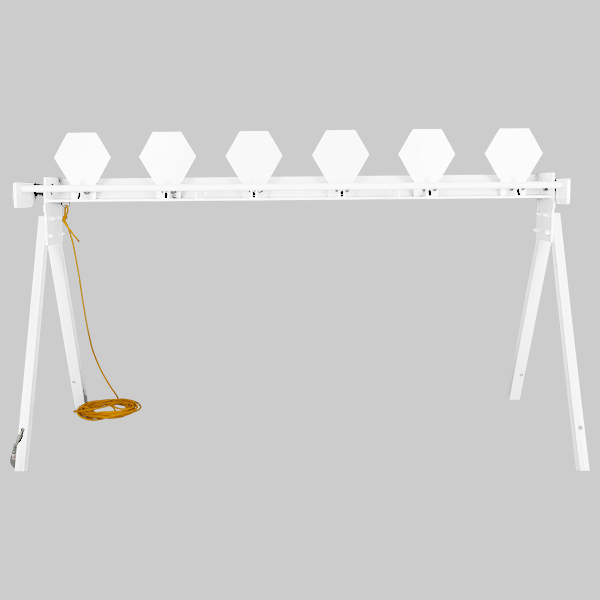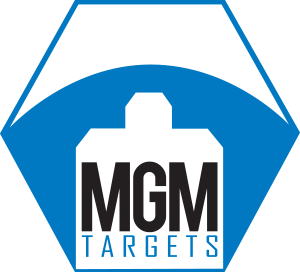Shooting Targets
What are the Best Types of Targets for Shooting?
Many novice shooters think of their guns as their primary training devices while only considering targets as an afterthought on the way to the range. Experienced shooters, however, know that a good target for practicing with pistols, rifles, or shotguns can mean the difference between a productive range day and a wallet full of wasted cash. Therefore, knowing what to shoot and where to get it is essential for developing your skills as a shooter and saving on ammo costs. Here’s a basic guide on types of targets and their advantages for you.
Shooting Target Materials
Although you can shoot any inanimate object, should you have the desire to do so, the top materials for target shooting are paper, polymer, and steel. Each comes with its own benefits and downsides. Each can also be limited by the rules and regulations of the ranges or properties you shoot on. For example, if you live in a big city, you may have to stick to bringing paper targets to the range. If you happen to have an Idaho ranch with plenty of space, you can have your pick of the best paper, polymer, and steel.
Paper and Cardboard Targets
Paper and cardboard are the basics with which most beginner shooters learn to shoot. This doesn’t mean, however, that experienced shooters never shoot paper. In fact, paper targets have a few advantages that make them an indispensable target for shooters of all skill levels. These are:
- Safe for close range
- Good for zeroing
- Good for verifying hits
- Ideal for identifying shooter weaknesses
Since paper and cardboard targets are soft, they can’t cause dangerous ricochets. Assuming you’ve cleared everything behind your target, shooting paper or cardboard is absolutely safe. However, shooting paper from long distances can be unrewarding, as it is rarely possible to identify your groups from greater than 50 or so yards, even with the best quality scopes on the market.
Paper targets are perhaps best used for close-range practice shooting and long-range zeroing or grouping. Many modern optics are built with a 100- or 200-yard zero in mind. Shooting paper makes it easy to adjust your optic to hit dead center on your bullseye. Once you’re zeroed, shooting paper at long ranges can tell you a lot about how your rifle responds to different ammunition types and loads.
When firing at close range, responsively colored targets can let you know whether you are flinching or pulling rounds. This is especially helpful when practicing with pistols, where flinching tends to be exaggerated enough to notice when firing unsupported at close range.
Polymer Targets
Polymer targets are relatively new additions to the world of shooting. Polymers are relatively cheap shooting targets compared with steel and serve as a mid-point between paper and steel.
There are currently a wide variety of plastic targets on the market, and they vary in durability from extremely tough to flimsy. There are also a wide variety of target styles, from poppers to trees. While expensive targets can cost as much as quality steel, cheap ones can make affordable, short-term alternatives to other responsive targets.
The advantages of polymer targets are:
- Low ricochet chance
- Instant visual feedback
- Inexpensive
- Portable
Though polymers don’t offer the distinct “pinging” sound of steel targets, they often give the shooter plenty of visual feedback to work with. Since they are unlikely to ricochet shots, they can be brought to almost any range. Polymer targets are best for pinking and practicing outside of serious competitions because they don’t offer audible feedback and aren’t as durable as steel.
Steel Targets
Steel targets are an excellent type of target for dynamic shooting. Because of its durability, steel is the gold standard for top-quality ranges and 3-gun shoots. Whenever you shoot steel, you hear an instant, audible ping. Many targets also offer visual feedback, making them excellent for training for tactical or competitive purposes.
The advantages of steel targets are:
- Instant feedback
- Extreme durability
- Standard for competitions
Unless you plan on blasting away all day with a 50 BMG, your steel is likely to outlast you. Steel can even withstand shotgun rounds and is a virtual necessity for training shotguns without a clay pigeon setup. However, when you use metal targets, you should be careful not to shoot high-velocity rounds at close range, as they can ricochet bullets and jacket material.
Steel targets really shine at distances greater than a hundred yards, at which most shooters have a hard time discerning hits without hiking out to a target. Audible feedback at long range can tell you a lot about your rifle and specific loads at long range, including where to hold at particular distances.
Shooting Target Styles
Today, there are many styles of targets available to shooters, and each offers its own benefits. To be a well-rounded shooter, you should have some familiarity with the main categories of targets.
Static Targets
Static targets are cheap practice targets that don’t move but can be inspected. Static targets tend to give you an extremely precise indication of where your rounds are hitting. When zeroing or minimizing rifle groups, having a precise, nonmoving target is absolutely necessary. Paper targets are among the most popular static targets, but painted steel can also be inspected to serve the same purpose in a pinch.
Feedback Targets
Feedback targets like poppers, gongs, and knock-over setups can give you an immediate indication of whether you hit your target or not. Feedback targets are great for training after you’ve zeroed. At medium range, they create instinctive shooting, and at long range, they can confirm your hits without requiring a cease-fire and a hike.
Feedback targets are probably the best targets for developing general shooting skills. Because you can move and maneuver around them, they can be great for getting rid of that “flat-range” mentality and practicing tactical shooting.
Skill Targets
Skill targets are designed for competing or practicing skills, such as moving between targets quickly. Target trees and whirly-gigs are popular examples. Skill targets provide instant shot feedback, but some can only be shot once without being set up again. These are usually best for experienced shooters who don’t need to work much on fundamentals. For pure fun, however, skill targets reign supreme.
Shop MGM Targets
Like anything in life, shooting requires practice. Although talent and experience often help, you won’t become the great shooter you’ve always wanted to be without practice. How you practice, however, is equally as important as merely getting out on the range. Perfect practice, after all, makes practice perfect.
Paper, cardboard, polymer, and steel are all legitimate ways to train and improve on whatever platform you shoot. Just remember, each target for shooting has its own purpose, as well as its own limits. Using your target the way it was meant to be used can keep you safe and speed up your learning process.
If you love shooting and have been looking for ways to train better, look no further than quality targets. At MGM Targets, we have everything you need for competition, recreation, and professional shooting. Shop targets at MGM online today.
Image Source: FocusDzign / Shutterstock


